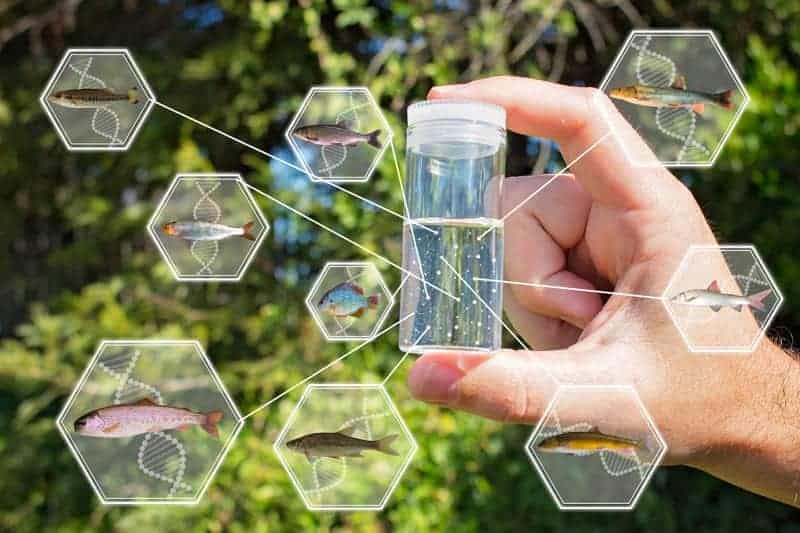Anglers often lament how hard it can be to land a fish for dinner, but the tougher job usually falls to fisheries managers, who have set sustainable catch limits for the fishes we love to harvest.
Traditionally, the size of a fish population is estimated using “mark and recapture” studies. To get those numbers, researchers must head to a body of water, pile into boats, catch a whole lot of the species of fish they’re after, tag and release them, and then return later to catch another mess of fish and look for ones they had previously tagged. By comparing the percentage of marked fish to the number recaptured, they can estimate the size of a population.
It’s a process that takes a lot of time and money and requires a fairly large crew to set nets, pull fish and count them, but also provides information on fish population size and age structure which is important for sustainable fisheries management.

But there may be a faster, cheaper and less labor intensive way to get at some of this important fishery data, says Mike Spear, a graduate student at the University of Wisconsin-Madison’s Center for Limnology. What’s more, during our current coronavirus pandemic, it’s a way that is ready-made for socially distant science.
Using his method, Spear says, “I can go out by myself, be off the lake in twenty minutes and go back to the lab and process the samples” all in a single day.
The secret is something called “environmental DNA,” or “eDNA,” which is, essentially, bits of genetic code living organisms leave behind in their environment. Humans shed dead skin cells or loose hairs, while fish leave waste in their wake that’s chock full of bits of their DNA.
In a study published June 7th in the journal, Environmental DNA, Spear and his colleagues headed out in search of walleye, one of Wisconsin’s most popular sportfish species and a staple of the Friday fish fry. Walleye aren’t just the target of most anglers, they are also a species that is in decline across the Midwest, making sustainable management a priority.
The problem, Spear says, is there are about 900 lakes in Wisconsin’s ceded territory that have walleye populations but, because of the time and effort traditional studies take, state and tribal fisheries managers can only monitor about 5% every year.
“So if they’re going out and only working up 45 lakes each year, what we hope is they would also be able to sample additional lakes using the eDNA method and at least get some information on a lot more lakes,” he says.

First, however, Spear and his colleagues had to prove that eDNA does offer insight into walleye populations in Wisconsin lakes. To do this, his crew sampled 24 different Wisconsin lakes that had recent walleye estimates from traditional sampling efforts. Using half-liter plastic bottles, they scooped water from the surface at several random locations across each lake, put the bottles on ice and headed back to the lab.
Once at the lab, the water was run through a filter, which separated out the water and, well, everything else. The team then searched for fragments of walleye DNA in this left over organic material. What they found, Spear says, is that there was “more or less a linear relationship between number of walleye in the lake and the number of eDNA hits we got.” In other words, lakes with healthy walleye populations produced a healthy dose of walleye eDNA while lakes estimated to have low walleye numbers turned up a similarly small amount of eDNA.
“There are still steps between where we are and this becoming a part of the fisheries management tool box,” Spear cautions, noting that, currently, his sampling method only paints a very broad picture of population dynamics – such as “should we close this lake [to walleye fishing] or should we open it,” based on eDNA estimates of either healthy or crashing walleye numbers.
This could help fisheries managers’ keep tabs on walleye health across many more lakes at a fraction of the cost of current monitoring methods. Then, he says, “if we see a lake’s walleye population cross from ‘fishable’ to ‘unfishable’ with eDNA methods, we could focus on it and go get a traditional population estimate.”
While that is one useful way to deploy eDNA in fishery management, Spear says what’s more exciting is that the tool seems ready to be fine-tuned.
Research on eDNA is exploding, Spear says. Until recently, scientists believed that eDNA broke down too quickly in the environment to identify fragments any further than what species it came from. But, “what we’re starting to find out is that you can recover much longer sequences of eDNA from the environment and actually get enough genetic code to get to the individual level like you would at a crime scene.”
If researchers can start reliably collecting and analyzing those kinds of samples, he says, “you could start to estimate the number of individual walleye in a lake.”
—
MEDIA CONTACTS:
Lead author: Mike Spear – [email protected]
Communications: Adam Hinterthuer – [email protected]
PAPER AVAILABLE HERE:
https://onlinelibrary.wiley.com/doi/full/10.1002/edn3.94
If our reporting has informed or inspired you, please consider making a donation. Every contribution, no matter the size, empowers us to continue delivering accurate, engaging, and trustworthy science and medical news. Independent journalism requires time, effort, and resources—your support ensures we can keep uncovering the stories that matter most to you.
Join us in making knowledge accessible and impactful. Thank you for standing with us!

